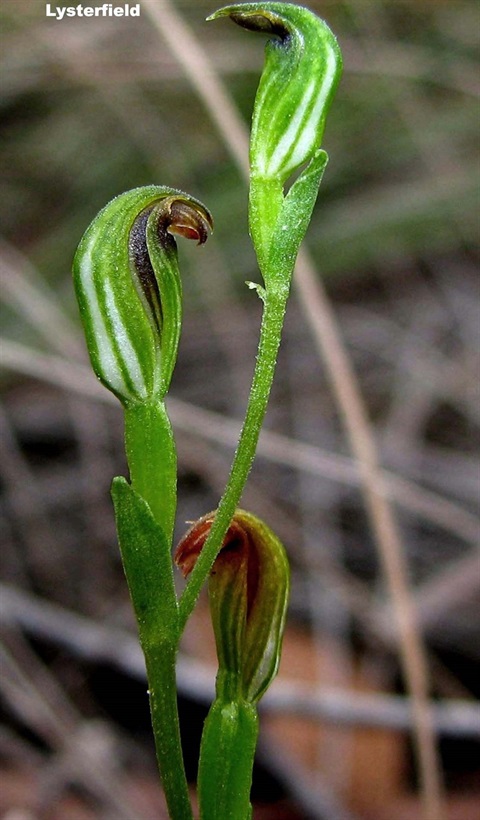
Pterostylis clivosa
Red-tipped or Corranwarrabul Greenhood
Perennial herb rising from round tubers to form loose colonies. Central sepal and petals united into a galea (hood) over the column and labellum (lip). Lateral sepals joined at the base, ending in fine points.
Additional information
- SynonymPterostylis sp. aff. parviflora (Eastern Melbourne), Separated from Pterostylis parviflora; Speculantha sp. aff. parviflora
- FamilyOrchidaceae
- StoreyLower storey
- Size8-20 cm high
- Plant groupingOrchids
- LeavesFlowering plants - 1-3 ground-hugging rosettes form on side shoots from the stem. 3-10 stalked egg-shaped grey-green leaves to 20 mm x 10 mm, with wavy margins. 2-4 closely sheathing stem leaves on wiry stem. Sterile plants have a small rosette.
- Flower colourWhite and green striped with green tinges, brown petals and lateral sepals
- Flowering timeMarch to May
- Flowers2-8 flowers to 12 mm, facing into stem. Hood mostly erect, top curved forward, tip blunt. Lateral sepals brown with white stripes, erect, gap broad, protruding, points to 3 mm. Lip just visible.
- Bird attractingNo
- Butterfly attractingNo
- Frog habitatNo
- Growing conditionsWell drained soils in moist forest and heathy woodlands which are moist in the growing season. Semi shade.
- Garden useUse of orchids in gardens is not recommended, unless they already occur naturally, in which case they need to be protected. Removing orchids from the bush usually results in their death and further depletes remaining wild orchid populations.
- Commercially availableNever
- Conservation statusRare in Victoria with few known populations. Significant within the Shire. Known from very few local sites.
- Aboriginal Use Food - tuber
- Related speciesThe brown petals and tips are the major distinguishing features separating this species from P. parviflora. It tends to grow in loose colonies around the base of trees.
Photo Gallery
Photographer/s: 1 David Hartlands ©; 2 David Francis NatureShare ©; 3 Cathy Powers ©; 4 Bernadette Lingham, iNaturalist Australia ©
Plant Communities